A case for taking the lane
 Mon, March 22, 2010
Mon, March 22, 2010 Near my home is a busy main street that I cannot avoid each time I go out for a ride. On my way home I always have to negotiate a place where the road splits; I go straight, but there is another road that goes off at a slight tangent to the right.
The speed limit is 45 mph and vehicles making this right turn do not slow to take it, they use it like a freeway off ramp. There is a situation where all traffic is traveling in the same direction; some go straight, some peel off to the right.
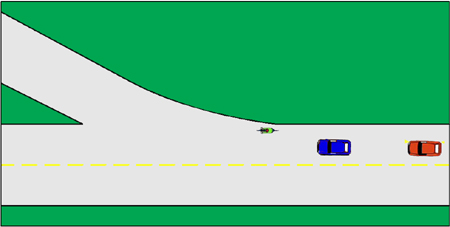
Illustrated above is a scenario where I am riding close to the right hand edge of the road and intend to go straight; the blue car about to pass me is also going straight. However, a red car following is turning right.
The driver of the red car probably can’t see me at this point; the blue car is obstructing his view; remember both cars are traveling at 45 mph which is about twice my speed.
Therefore in the next few seconds both cars remain at the same distance apart from each other, but they have traveled twice the distance I have, and we are all roughly is this next position.
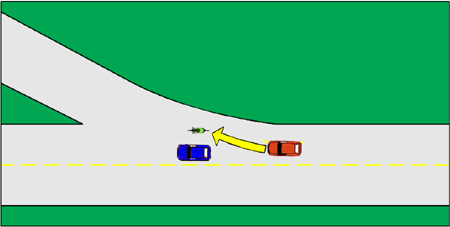
The blue car is passing, and the red car is now on a collision course with me. He may have seen me by now, but given his speed and his reaction time; at best it is going to be a close call.
The Solution
I am very much aware of this possibility, and before the road splits I look behind for a gap in traffic. As soon as it is safe to do so, I give a hand signal and move over to the left; taking up about a third of the lane.
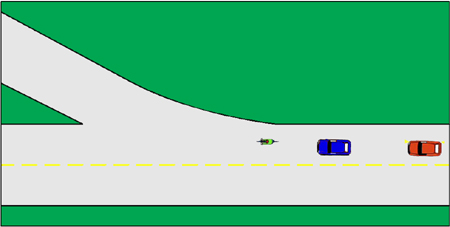 Now the blue car will probably slow and stay behind me (Above.) ; and becomes my safety buffer. The red car is no danger to me, and it is obvious the driver of the blue car that I intend to go straight.
Now the blue car will probably slow and stay behind me (Above.) ; and becomes my safety buffer. The red car is no danger to me, and it is obvious the driver of the blue car that I intend to go straight.
 Even if the blue car decides to go around me,(Above.) his action of swinging wide and crossing the center line, alerts the driver of the red car of my presence. Plus because I am riding more to the center of the lane, there is more room for the red car to pass me on the right.
Even if the blue car decides to go around me,(Above.) his action of swinging wide and crossing the center line, alerts the driver of the red car of my presence. Plus because I am riding more to the center of the lane, there is more room for the red car to pass me on the right.
Of course there is always the possibility the red car will still try to go around me then turn right. But should I find a car alongside me, trying to make a turn; I would make a quick dive to the right. Not where I intended to go, but I would have avoided a collision. (See “Look out for the right hook.)
Once I am clear of this junction, I move back over to the right. I am out in the lane 25 or 30 seconds at the most. I rarely get honked at, and if I do I ignore it. Giving someone “The Look” only makes matters worse; I try to give an impression of assertiveness, not arrogance.
“Taking the lane” can be a life saving maneuver; but use it wisely and only when necessary. Recognize special hazards like the one I have just described; especially ones on routes you use all the time. Decide how you will handle the situation, and have a plan “B.”
My plan B is: If traffic is traveling too fast and too close for me to take the lane, I simply signal and make a right myself, and go home by a slightly different route.

















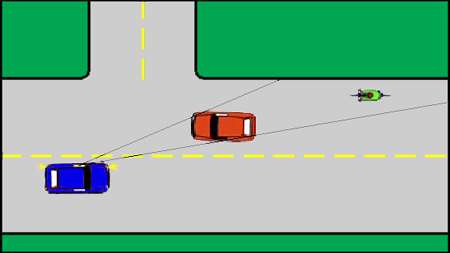
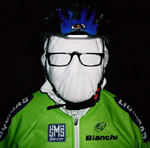
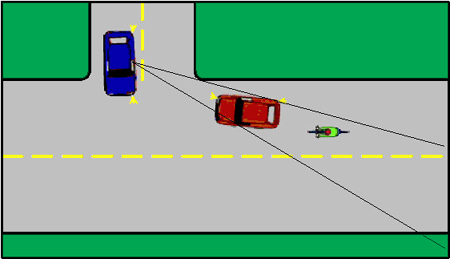
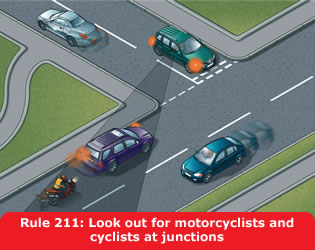
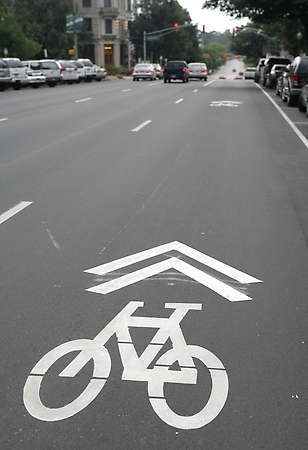


Please don’t ride your bike on the sidewalk
Gerardo Ramos was a 51 year old Mexican immigrant, who at 6:45 am was riding his bike to work in Glendale, California. A woman failed to stop at a stop sign; Gerardo’s head hit the windshield, and he suffered massive head injuries.
He was not expected to live more than a few hours, but he remained in a coma for 13 months before dying from his injuries. The 48 year old woman driver has now been charged with a misdemeanor count of vehicular manslaughter.
I came across this story via Biking LA blog, where the writer led with the line, “Kill a bike rider in Glendale, get a slap on the wrist.”
The police have stated the reason this is a “misdemeanor” charge is because although the driver failed to stop, the cyclist was riding on the sidewalk, which is against the law in Glendale. Both parties were breaking the law.
It is quite easy, as cyclists, to get our anti-bacterial padded shorts in a twist over a case like this; after all the man on the bike paid for his mistake with his life. Very tragic indeed, I will agree.
The report on the incident does not say from which direction the cyclist was traveling; I suspect he was traveling in the wrong direction approaching from the right.
The reason I surmise this is because: A.) The driver making an illegal rolling stop, would most likely looking to the left first, as this is the direction she would expect traffic to come from. B.) Had the cyclist been approaching from the left he would have seen the car approach, and had the full width of the road to stop, or steer a course behind the car.
Like I say, I do not know if this was the case, but it is typical of how these incidents happen. I have had it happen to me when I have been driving. Just recently I was leaving a restaurant parking lot; the sidewalk was clear, and I sat with the front of my car across the sidewalk in order to see approaching traffic to my left.
As I waited for a break in traffic, I was startled when a man on a bike rode around the front of my car. Approaching on the sidewalk from the right, he swerved into the road, and then back onto the sidewalk
What if the cyclist passing in front of my car had corresponded with a break in traffic and I had pulled out, I could have knocked him clear across the road and into the path of opposing traffic.
Had the man been killed, would I have then been charged with misdemeanor vehicular manslaughter, and would cycling bloggers rush to judgment and call it a “Slap on the wrist?”
Where I live there are many low income people who ride bicycles as their sole means of transport. They ride on the sidewalk, or they ride in the road, contra to the traffic flow. Doing so gives them a false sense of security.
Don't do it. Riding on the sidewalk is against the law in most places, and motorists are not looking for you there, especially if you are approaching from the wrong direction. The same goes for riding on the street in the wrong direction.
If you must ride on the sidewalk, do so only where it is legal. At least ride the same direction as traffic, and stop at ever intersection. I’m not sure how to get this message out because none of these low income people are likely to own a computer, much less read this article.
The woman driver from Glendale was wrong, had she stopped Gerado Ramos would have passed by. However, under the circumstances I don’t see a charge of misdemeanor vehicular manslaughter as a slap on the wrist. Many motorists run down and kill cyclists riding on the road lawfully, and are never charged with anything.
People driving cars sometimes drive carelessly and dangerously, but we as people who ride bikes must at least give a car driver a fighting chance at missing us. That means not suddenly appearing from the wrong direction, whether on the road or sidewalk